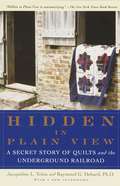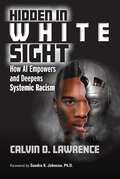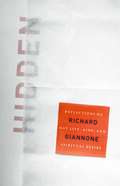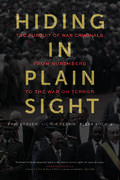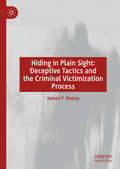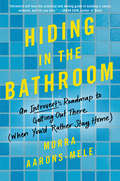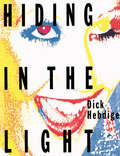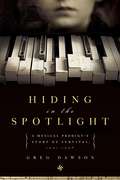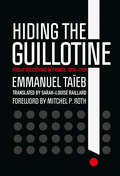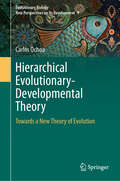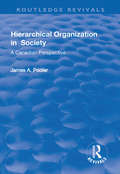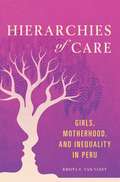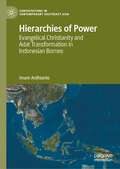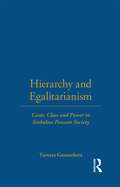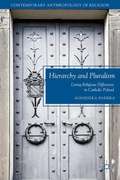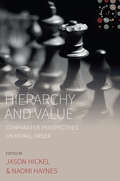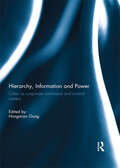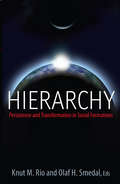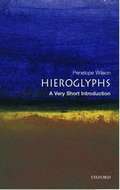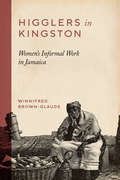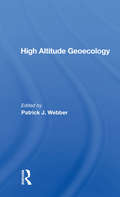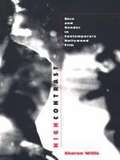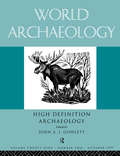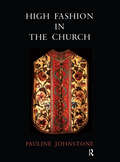- Table View
- List View
Hidden in Plain View: A Secret Story of Quilts and the Underground Railroad
by Jacqueline L. Tobin Raymond G. DobardThe fascinating story of a friendship, a lost tradition, and an incredible discovery, revealing how enslaved men and women made encoded quilts and then used them to navigate their escape on the Underground Railroad. In Hidden in Plain View, historian Jacqueline Tobin and scholar Raymond Dobard offer the first proof that certain quilt patterns, including a prominent one called the Charleston Code, were, in fact, essential tools for escape along the Underground Railroad. In 1993, historian Jacqueline Tobin met African American quilter Ozella Williams amid piles of beautiful handmade quilts in the Old Market Building of Charleston, South Carolina. With the admonition to "write this down," Williams began to describe how slaves made coded quilts and used them to navigate their escape on the Underground Railroad. But just as quickly as she started, Williams stopped, informing Tobin that she would learn the rest when she was "ready." During the three years it took for Williams's narrative to unfold—and as the friendship and trust between the two women grew—Tobin enlisted Raymond Dobard, Ph.D., an art history professor and well-known African American quilter, to help unravel the mystery.Part adventure and part history, Hidden in Plain View traces the origin of the Charleston Code from Africa to the Carolinas, from the low-country island Gullah peoples to free blacks living in the cities of the North, and shows how three people from completely different backgrounds pieced together one amazing American story.With a new afterword. Illlustrations and photographs throughout, including a full-color photo insert.
Hidden in White Sight: How AI Empowers and Deepens Systemic Racism
by Calvin D. LawrenceArtificial Intelligence was meant to be the great social equalizer that helps promote fairness by removing human bias from the equation, but is this true? Given that the policing and judicial systems can display human bias, this book explores how the technology they use can also reflect these prejudices. From healthcare services to social scoring in exams, to applying for and getting loans, AI outcomes often restrict those most in need of these services. Through personal stories from an esteemed Black Data Scientist and AI expert, this book attempts to demystify the algorithmic black box. AI pervades all aspects of modern society and affects everyone within it, yet its internal biases are rarely confronted. This book advises readers on what they can do to fight against it, including the introduction of a proposed AI Bill of Rights, whilst also providing specific recommendations for AI developers and technologists. https://hiddeninwhitesight.com/
Hidden: Reflections on Gay Life, AIDS, and Spiritual Desire
by Richard GiannoneHidden—Richard Giannone’s searingly honest, richly insightful memoir—eloquently captures the author’s transformation from a solitary gay academic to a dedicated caregiver as well as a sexually and spiritually committed man. Always alone, always fearful, he initially resisted the duty to look after his dying female relatives. But his mother’s fall into dementia changed all that. Her vulnerability opened this middle-aged man to the love of another man, a former priest and Jersey boy like himself. Together the two men saw the old woman to her death and did the same for Giannone’s sister. In Hidden Giannone uncovers how, ultimately, these experiences moved him closer to participating in the vitality he believed pulsed in the world but had always eluded him.The mothering life of this gay partnership evolved alongside the AIDS crisis and within and against Italian American culture that reflected the Catholic Church’s discountenancing of homosexual love. Giannone vividly weaves his reflections on gay life in Greenwich Village and his spiritual journey as a gay man and Catholic into his experience of caring for the women of his family.In Hidden Giannone recounts a gripping religious conversion, drawing on the wisdom of the ancient desert mothers and fathers of Egypt and Palestine. Because he was raised a Catholic, the shift is not from nothing to something. Rather, it is away from the modeling power of institutional Christianity to the tempering influence of homosexuality on the Gospel. Gay or straight, so long as we remain hidden from ourselves, the true God remains hidden from us.
Hiding in Plain Sight
by Eric Stover Victor Peskin Alexa KoenigHiding in Plain Sight tells the story of the global effort to apprehend the world's most wanted fugitives. Beginning with the flight of tens of thousands of Nazi war criminals and their collaborators after World War II, then moving on to the question of justice following the recent Balkan wars and the Rwandan genocide, and ending with the establishment of the International Criminal Court and America's pursuit of suspected terrorists in the aftermath of 9/11, the book explores the range of diplomatic and military strategies--both successful and unsuccessful--that states and international courts have adopted to pursue and capture war crimes suspects. It is a story fraught with broken promises, backroom politics, ethical dilemmas, and daring escapades--all in the name of international justice and human rights.Hiding in Plain Sight is a companion book to the public television documentary Dead Reckoning: Postwar Justice from World War II to The War on Terror. For more information about the documentary, visit www.saybrookproductions.com. For information about the Human Rights Center, visit hrc.berkeley.edu.
Hiding in Plain Sight: Deceptive Tactics and the Criminal Victimization Process
by James F. KennyThis book examines the role of deceptive tactics in the criminal victimization process, showing how various forms of manipulative aggression can help disguise dangerous advances. The author approaches crime victimization as the final stage in a purposeful, predictable, dynamic, and progressively dangerous process involving interactions between the target and the aggressor. As they prepare for the attack, aggressors may attempt to distract, confuse, and reduce target resistance. While these tactics provide aggressors certain advantages, they can be recognized, anticipated, and managed. By presenting a framework to identify behaviors of concern early in the process, Kenny shows how preventative action can be taken. Proactive intervention may cause aggressors to withdraw before they are fully committed to and confident in their ability to be successful. Those who take steps to reduce vulnerabilities, limit risky behaviors, and avoid dangerous situations can help prevent themselves from being victimized.
Hiding in the Bathroom: An Introvert's Roadmap to Getting Out There (When You'd Rather Stay Home)
by Morra Aarons-Mele“Introverts will love this practical and moving guide to building a career, network, and life you love.” - Susan Cain, author of Quiet From the marketing guru and host of the popular podcast Hiding in the Bathroom, a breakthrough introverts' guide that broadens the conversation sparked by Quiet and moves away from the "Lean In" approach, offering wisdom and practical tips to help readers build strong relationships and achieve their own definition of professional success.Most ambitious people believe that reaching the peaks of success means being on 24/7—tirelessly networking, deal-making, and keynoting conferences. This is nonsense, says Morra Aarons-Mele. As an eminent entrepreneur with a flourishing business and a self-proclaimed introvert with lots of anxieties, Morra disagrees with the notion that there’s only one successful "type": the intense, super social, sleep-deprived mover and shaker, the person who musters endless amounts of "grit." Hiding in the Bathroom is her antidote for everyone who is fed up with feeling like they must always "lean in"—who prefer those moments of hiding in the bathroom to constantly climbing the ladder or working the room.Morra knows what it takes to make your mark, and now, this entrepreneur who has boosted the online strategy of clients such as the Malala Fund, President Obama, the UN Foundation, and the Bill and Melinda Gates Foundation shares the insights, tricks, and knowledge she’s learned. Filled with advice, exercises to help readers evaluate their own work/life fit and manage anxiety, valuable tools, and stories of countless successful people—entrepreneurs, academics, and novices just beginning their careers—Hiding in the Bathroom empowers professionals of all ages and levels to take control and build their own versions of success. Thoughtful and practical, it is a must-have handbook for building a fantastic, prosperous career and a balanced, happy life—on your own terms.
Hiding in the Light: On Images and Things (Comedia)
by Dick HebdigeDick Hebdige looks at the creation and consumption of objects and images as diverse as fashion and documentary photographs, 1950's streamlined cars, Italian motor scooters, 1980's 'style manuals', Biff cartoons, the Band Aid campaign, Pop Art and promotional music videos. He assesses their broad cultural significance and charts their impact on contemporary popular tastes.
Hiding in the Spotlight: A Musical Prodigy's Story of Survival, 1941-1946
by Greg DawsonZhanna, a young Jewish girl from Ukraine and a gifted piano prodigy giving concerts by the age of six, manages to escape the famed Nazi death march to Dorbitsky Yar and uses her musical gift to help her survive. Giving concerts for the occupying German troops as they move throughout Europe, Zhanna keeps her true identity a secret until a young American soldier adopts her. Upon her emigration to America, Zhanna's gift flourishes and she becomes one of the first Jewish refugees to enter Julliard.
Hiding the Guillotine: Public Executions in France, 1870–1939
by Emmanuel TaïebHiding the Guillotine examines the question of state involvement in violence by tracing the evolution of public executions in France. Why did the state move executions from the bloody and public stage of the guillotine to behind prison doors? In a fascinating exploration of a grim subject, Emmanuel Taïeb exposes the rituals and theatrical form of the death penalty and tells us who watched, who participated in, and who criticized (and ultimately brought an end to) a spectacle that the state called "punishment." France's abolition of the death penalty in 1981 has long overshadowed its suppression of public executions over forty years earlier. Since the Revolution, executions attracted tens of thousands of curious onlookers. But, gradually, there was a shift in attitude and the public no longer saw this as a civilized pastime. Why? Combining material from legal archives, police files, an executioner's notebooks, newspaper clippings, and documents relating to 566 executions, Hiding the Guillotine answers this question.Taïeb demonstrates the ways in which the media was at the vanguard of putting an end to the publicity surrounding the death penalty. The press had ample reason to be critical: cities were increasingly being used for leisure activity and prisons for those accused of criminal activity. The agitation surrounding each execution, coupled with a growing identification with the condemned, would blur these boundaries. Ranked among the top hundred history books by the website, Café du Web Historizo, Hiding the Guillotine has much to impart to students of legal history, human rights, and criminology, as well as to American historians.
Hierarchical Evolutionary-Developmental Theory: Towards a New Theory of Evolution (Evolutionary Biology – New Perspectives on Its Development #9)
by Carlos OchoaThis book introduces a new evolutionary model called &“Hierarchical Evolutionary-Developmental Theory&” or &“H-Evo-Devo Theory.&” This theory proposes that the organism&’s internal properties reflect entities that are highly integrated in developmental terms that evolve hierarchically. In other words, it attempts to demonstrate that developmental constraints operate at different scales, producing distinct states of morphological stability reflected as subspecies, species, higher taxa, and homologues, all representing units of evolution. In addition, it reintroduces the concept of the &“organism&” in evolutionary biology, supports a strictly macroevolutionary view, and contemplates alternative evolutionary rates, processes, and mechanisms at different levels: microevolution, macroevolution, megaevolution, and modular-evolution. In short, this book establishes a new synthesis between systematics, morphology, and evolution, suggesting a significant shift in evolutionary thought. The book comprises:1. A proposal for a new theory of evolution and systematics: The H-Evo-Devo Theory reinterprets the concepts of subspecies, species, higher taxa, and homologues, proposing that the phylogenetic tree is built on a hierarchy of types, developed from the top-down, in contrast to the traditional bottom-up approach.2. A novel hierarchical perspective that reveals the underlying mechanisms acting on the patterns of divergence, stability, and extinction of the units of evolution.3. A resolution to the ontological problem regarding units of evolution (e.g., the reality of species and higher taxa).4. A historical narrative that focuses on the development of a hierarchy theory of evolution grounded in the type concept and the significance of an organism-centered perspective.5. A challenge to traditional frameworks that have sought to establish hierarchies in an evolutionary context.6. A challenge to classical evolutionary statements such as gradualism, punctuated equilibrium, the extrapolationist premise, and geographical models of speciation. This book is written for those who feel that radical change is needed in evolutionary theory, offering them a viable alternative.
Hierarchical Linear Modeling: Guide and Applications
by Professor G. David GarsonThis book provides a brief, easy-to-read guide to implementing hierarchical linear modeling using three leading software platforms, followed by a set of original how-to applications articles following a standardard instructional format. The "guide" portion consists of five chapters by the editor, providing an overview of HLM, discussion of methodological assumptions, and parallel worked model examples in SPSS, SAS, and HLM software. The "applications" portion consists of ten contributions in which authors provide step by step presentations of how HLM is implemented and reported for introductory to intermediate applications.
Hierarchical Organization in Society
by James A PoolerThis title was first publiished in 2000: A hierarchy is an organization system that is structured in a treelike manner, with levels of status or authority stacked one above the other. The classical and best known example of a hierarchy is probably the typical diagram that describes the structure of a company or business, also known as the corporate ladder. This text argues that hierarchies are one of the most important concepts we have in order to understand the world around us, and looks at hierarchies in a wide variety of areas of interest to everybody, such as companies, educational systems, transport systems, retail stores, corporations, communities, population migrations, medical systems, and many other real-world phenomena. From a Canadian perspective, the text examines these hierarchies and their effects at a variety of scales. It discusses how to understand the system around us and the ones in which we are immersed every day. The central theme is that it is possible to get a better grip on the past, present and future of the world, if it is viewed through an understanding of hierarchies.
Hierarchies of Care: Girls, Motherhood, and Inequality in Peru (Interp Culture New Millennium #1)
by Krista E Van VleetPalomitáy is an orphanage in highland Peru that provides a home for unmarried mothers as young as twelve years old. In their ordinary lives, these young women encounter diverse social expectations and face moral dilemmas. They endeavor to create a ‘good life’ for themselves and their children in a context complicated by competing demands, economic uncertainties, and structured relations of power. Drawing on a year of qualitative on-site research, Krista E. Van Vleet offers a rich ethnography of Palomitáy's young women. She pays particular attention to the moral entanglements that emerge via people's efforts to provide care amid the inequalities and insecurities of today's Peru. State and nonstate participants involved in the women's intimate lives influence how the women see themselves as mothers, students, and citizens. Both deserving of care and responsible for caring for others, the young women must navigate practices interwoven with a range of a racial, gendered, and class hierarchies. Groundbreaking and original, Hierarchies of Care highlights the moral engagement of young women seeking to understand themselves and their place in society in the presence of circumstances that are both precarious and full of hope.
Hierarchies of Power: Evangelical Christianity and Adat Transformation in Indonesian Borneo (Contestations in Contemporary Southeast Asia)
by Imam ArdhiantoThis book focuses on a Pentecostal-Evangelical Kenyah community in central Borneo, a region that crosses the border between Malaysia and Indonesia. The book argues that the Pentecostal-Evangelical (P/e) mode of religious authority and organization has the capacity to adapt to both the pre-existing hierarchical traditional institution such as Adat and modern egalitarian social forms. It has been necessary within the context of Kenyah’s experience of religious change as it enabled many actors from various social classes to obtain and perceive religious authority in a specific local and regional political-religious situation while promoting their identity as egalitarian and autonomous modern subjects. In contrast with other studies on the P/e church that emphasize its egalitarian spirit as a factor that supports its impressive growth, the book contends that its adaptive structural characteristics have enabled the development of this specific Christian denomination to expand rapidly and play a dominant position in contemporary social life in various parts of the world. The book thus provides novel findings in the study of religious change in Southeast Asia by enriching the discussion of historical transformation in the region, and analyzing the articulation of global and regional Christian movements, with the socio-political characteristics of Bornean society.
Hierarchy and Egalitarianism: Caste, Class and Power in Sinhalese Peasant Society (London School Of Economics Monographs On Social Anthropology Ser. #No. 65)
by Tamara GunasekeraA comprehensive analysis of stratification in rural Sri Lanka, taking into account the hierarchies of class, status and power.
Hierarchy and Pluralism
by Agnieszka PasiekaBased on an ethnographic study of rural Poland, this book investigates the challenges of maintaining pluralism in a religiously homogenous society. By examining a multireligious and multiethnic community, Pasieka reveals paradoxes inscribed into the practice and discourse of pluralism.
Hierarchy and Value: Comparative Perspectives on Moral Order (Studies in Social Analysis #7)
by Jason Hickel Naomi HaynesGlobalization promised to bring about a golden age of liberal individualism, breaking down hierarchies of kinship, caste, and gender around the world and freeing people to express their true, authentic agency. But in some places globalization has spurred the emergence of new forms of hierarchy—or the reemergence of old forms—as people try to reconstitute an imagined past of stable moral order. This is evident from the Islamic revival in the Middle East to visions of the 1950s family among conservatives in the United States. Why does this happen and how do we make sense of this phenomenon? Why do some communities see hierarchy as desireable? In this book, leading anthropologists draw on insightful ethnographic case studies from around the world to address these trends. Together, they develop a theory of hierarchy that treats it both as a relational form and a framework for organizing ideas about the social good.
Hierarchy, Information and Power: Cities as Corporate Command and Control Centers
by Hongmian GongThis book is a collection of selected papers presented in the 2012 annual meeting of the Association of American Geographers in New York honoring James O. Wheeler (1938-2010). The eight papers are informed and inspired by James O. Wheeler's many contributions to urban geography, particularly in the areas of urban hierarchy, information flows, cities in the telecommunications age, and cities as corporate command and control centers. They adopt and extend Jim Wheeler’s corporate and/or hierarchical approaches to discuss institutional investment in the U.S., corporate interlocking directorates and fast-growing firms in Canada, corporate intangible assets in South Korea, urban development in Beijing and Macau, and social and cultural diversity of global cities such as New York. Although these two approaches are not the fanciest ones in today's urban geography, they are essential to the understanding of how urban areas are connected and what drives this interconnectedness in this age of globalization. This book was previously published as a special issue of Urban Geography.
Hierarchy: Persistence and Transformation in Social Formations
by Olaf H. Smedal Knut M. RioLouis Dumont's concept of hierarchy continues to inspire social scientists. Using it as their starting point, the contributors to this volume introduce both fresh empirical material and new theoretical considerations. On the basis of diverse ethnographic contexts in Oceania, Asia, and the Middle East they challenge some current conceptions of hierarchical formations and reassess former debates - of post-colonial and neo-colonial agendas, ideas of "democratization" and "globalization," and expanding market economies - both with regard to new theoretical issues and the new world situation.
Hieroglyphs: A Very Short Introduction
by Penelope WilsonHieroglyphs were far more than a language. They were an omnipresent and all-powerful force in communicating the messages of ancient Egyptian culture for over three thousand years; used as monumental art, as a means of identifying Egyptianness, and for rarefied communication with the gods. In this exciting new study, Penelope Wilson explores the cultural significance of the script with an emphasis on previously neglected areas such as cryptography, the continuing decipherment into modern times, and examines the powerful fascination hieroglyphs still hold for us today.
Higglers in Kingston: Women's Informal Work in Jamaica
by Winnifred Brown-GlaudeMaking a living in the Caribbean requires resourcefulness and even a willingness to circumvent the law. Women of color in Jamaica encounter bureaucratic mazes, neighborhood territoriality, and ingrained racial and cultural prejudices. For them, it requires nothing less than a herculean effort to realize their entrepreneurial dreams. In Higglers in Kingston, Winnifred Brown-Glaude puts the reader on the ground in frenetic urban Kingston, the capital and largest city in Jamaica. She explores the lives of informal market laborers, called "higglers," across the city as they navigate a corrupt and inaccessible "official" Jamaican economy. But rather than focus merely on the present-day situation, she contextualizes how Jamaica arrived at this point, delving deep into the island's history as a former colony, a home to slaves and masters alike, and an eventual nation of competing and conflicted racial sectors.Higglers in Kingston weaves together contemporary ethnography, economic history, and sociology of race to address a broad audience of readers on a crucial economic and cultural center.
High Altitude Geoecology
by Patrick J. WebberThis book is concerned with section 6 of the United Nations Educational, Scientific, and Cultural Organization (UNESCO) program, "Impact of Human Activities on Temperate and Tropical Mountain and Tundra Ecosystems."
High Contrast: Race and Gender in Contemporary Hollywood Films
by Sharon WillisIn High Contrast, Sharon Willis examines the dynamic relationships between racial and sexual difference in Hollywood film from the 1980s and 1990s. Seizing on the way these differences are accentuated, sensationalized, and eroticized on screen--most often with little apparent regard for the political context in which they operate--Willis restores that context through close readings of a range of movies from cinematic blockbusters to the work of the new auteurs, Spike Lee, David Lynch, and Quentin Tarantino.Capturing the political complexity of these films, Willis argues that race, gender, and sexuality, as they are figured in the fantasy of popular film, do not function separately, but rather inform and determine each other's meaning. She demonstrates how collective anxieties regarding social difference are mapped onto big budget movies like the Die Hard and Lethal Weapon series, Basic Instinct, Fatal Attraction, Thelma and Louise, Terminator 2, and others. Analyzing the artistic styles of directors Lynch, Tarantino, and Lee, in such films as Wild at Heart, Pulp Fiction, and Do the Right Thing, she investigates how these interactions of difference are linked to the production of specific authorial styles, and how race functions for each of these directors, particularly in relation to gender identity, erotics, and fantasy.
High Definition Archaeology: World Archaeology Volume 29 Issue 2
by John A. J. GowlettThe use of modern analyses of high definition data is used to trace relationships or decision paths which could not have been seen with the techniques available 30 years ago. Examples are drawn from a variety of areas and periods.
High Fashion in the Church: The Place of Church Vestments in the History of Art from the Ninth to the Nineteenth Century
by Pauline JohnstoneThis book focuses on second half of the twentieth century, for strange things have been happening in the church. It aim is to show something of the origins and use of the vestments themselves, and to traces the development of their decoration in the context of the arts.
